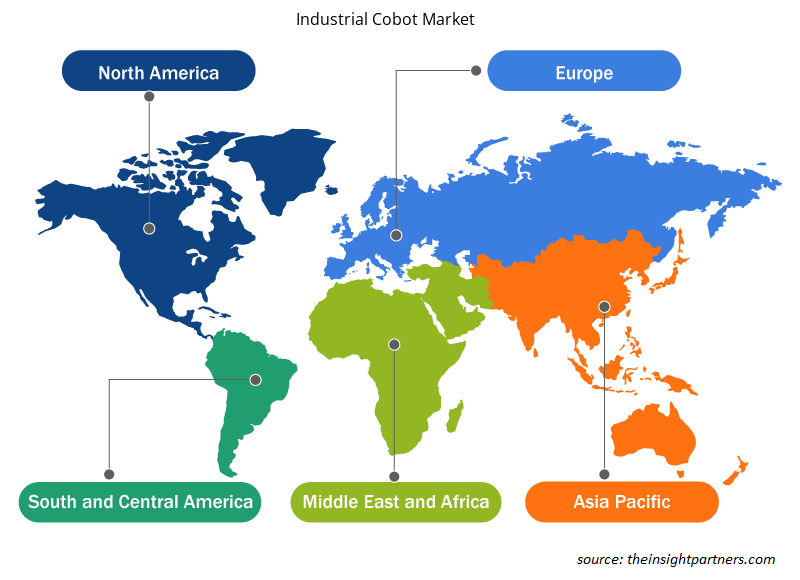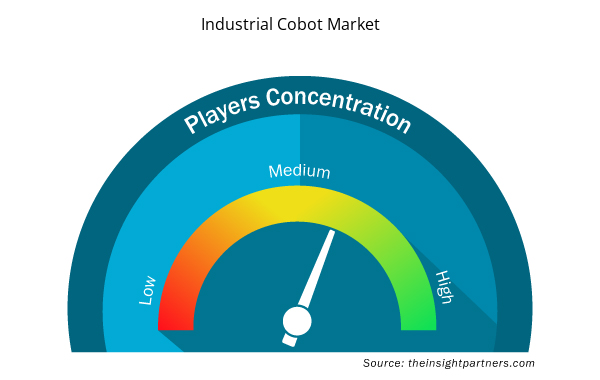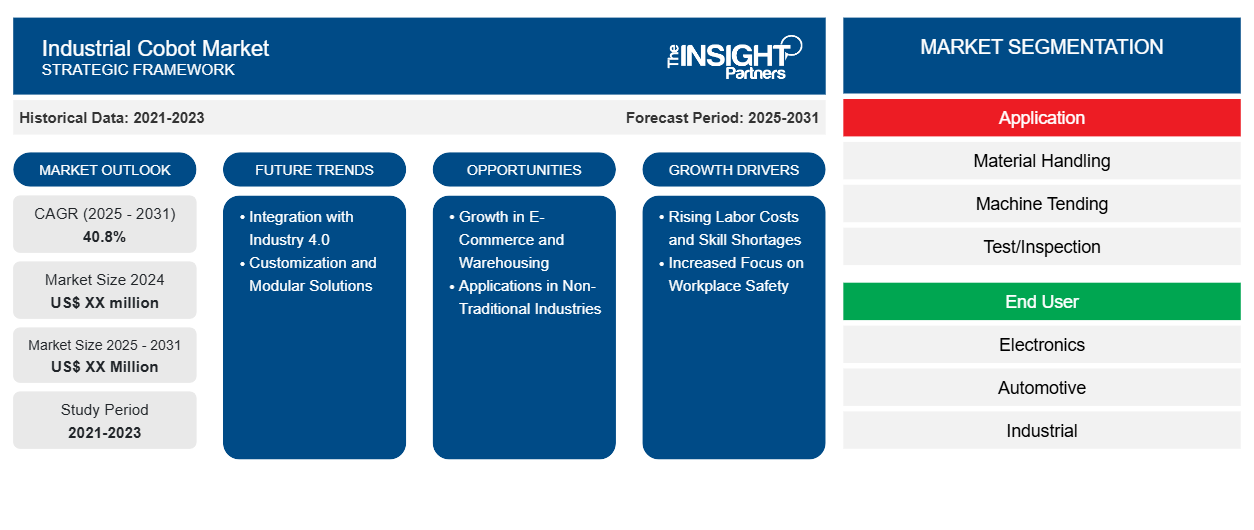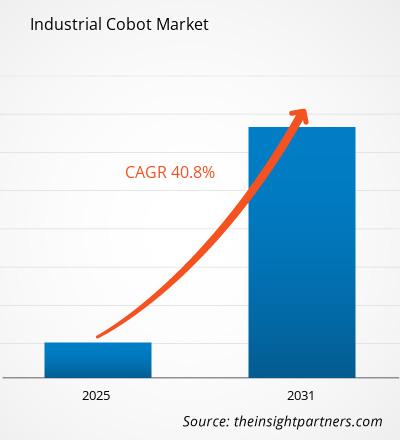産業用協働ロボット市場は、2023年から2031年にかけて40.8%のCAGRで成長し、市場規模は2023年のXX百万米ドルから2031年にはXX百万米ドルに拡大すると予想されています。
産業用コボット市場は、アプリケーション(マテリアルハンドリング、マシンテンディング、テスト/検査、付加価値処理、輸送)、エンドユーザー(エレクトロニクス、自動車、産業、航空宇宙および防衛、ヘルスケア、その他)、および地域(北米、ヨーロッパ、アジア太平洋、中東およびアフリカ、南米および中米)別に分析されています。
報告書の目的
The Insight Partners による産業用コボット市場レポートは、現在の状況と将来の成長、主な推進要因、課題、機会を説明することを目的としています。これにより、次のようなさまざまなビジネス関係者に洞察が提供されます。
- テクノロジープロバイダー/メーカー: 進化する市場の動向を理解し、潜在的な成長機会を把握することで、情報に基づいた戦略的意思決定が可能になります。
- 投資家: 市場の成長率、市場の財務予測、バリュー チェーン全体に存在する機会に関する包括的な傾向分析を実施します。
- 規制機関: 市場の濫用を最小限に抑え、投資家の信用と信頼を維持し、市場の完全性と安定性を維持することを目的として、市場における政策と警察活動を規制します。
産業用コボット市場のセグメンテーション
応用
- マテリアルハンドリング
- 機械による管理
- テスト/検査
- 付加価値加工
- 輸送
エンドユーザー
- エレクトロニクス
- 自動車
- 産業
- 航空宇宙および防衛
- 健康管理
- その他
要件に合わせてレポートをカスタマイズする
このレポートの一部、国レベルの分析、Excelデータパックなど、あらゆるレポートを無料でカスタマイズできます。また、スタートアップや大学向けのお得なオファーや割引もご利用いただけます。
- このレポートの主要な市場動向を入手してください。この無料サンプルには、市場動向から見積もりや予測に至るまでのデータ分析が含まれます。
産業用コボット市場の成長要因
- 人件費の上昇とスキル不足: 特に先進地域では人件費が上昇し続けているため、業界では反復作業や危険な作業を自動化するために協働ロボット (コボット) を導入するケースが増えています。コボットは人間のオペレーターと一緒に作業できるため、熟練労働者の必要性が減り、人手不足が緩和されます。コボットは生産性を向上させながら職場での怪我のリスクを最小限に抑えるため、業務の合理化を目指す企業にとってコスト効率の高いソリューションとなります。
- 職場の安全性への注目度の高まり: 職場の安全性は、コボット導入の大きな推進力です。これらのロボットは、従来の産業用ロボットとは異なり、安全ケージやバリアを必要とせずに人間の作業員と安全にやり取りできるように設計されています。コボットは、重いものを持ち上げたり、危険物を使った作業などの危険な作業を自動化することで、職場での怪我のリスクを軽減し、製造、自動車、電子機器などの業界における全体的な安全基準を向上させます。
産業用コボット市場の将来動向
- インダストリー 4.0 との統合: 産業用コボットは、スマート ファクトリー、IoT デバイス、リアルタイム データ分析を含む、より広範なインダストリー 4.0 エコシステムへの統合が進んでいます。コボットは他の自動化システムと相互接続されるようになり、生産ライン全体でシームレスな通信とデータ共有が可能になります。この接続により、製造業者はプロセスを最適化し、パフォーマンスを追跡し、意思決定を改善して、リアルタイムの監視と予測メンテナンスを容易に行うことができます。
- カスタマイズとモジュール式ソリューション: さまざまなアプリケーションや業界に簡単に適応できる、カスタマイズ可能でモジュール式のコボット ソリューションの開発が進んでいます。メーカーは、柔軟なアーム、交換可能なエンド エフェクタ、企業が特定のタスクに合わせてロボットをカスタマイズできる構成可能なソフトウェアを備えたコボットを設計しています。この傾向により、コボットはより汎用性が高くなり、独自の自動化ニーズを持つ中小企業 (SME) にとって利用しやすくなります。
産業用コボットの市場機会
- 電子商取引と倉庫管理の成長: 電子商取引の急増と、より迅速なフルフィルメント時間の需要の高まりにより、倉庫管理と物流における協働ロボットのチャンスが生まれています。協働ロボットは、ピッキング、梱包、仕分けなどの作業を自動化し、フルフィルメント センターの速度と精度を大幅に向上させます。電子商取引が拡大し続けるにつれて、物流業務における効率的で適応性の高い協働ロボットの必要性が高まり、市場に大きな成長の機会をもたらします。
- 非伝統的産業におけるアプリケーション: 食品加工、製薬、電子機器などの非伝統的産業では、産業用コボットの新たな機会が生まれています。食品業界では、コボットは包装、仕分け、品質管理に使用されます。製薬業界では、コボットは正確な分配、組み立て、包装を支援します。業界が自動化においてより高い精度と柔軟性を求めるにつれて、特殊なアプリケーションでのコボットの需要が高まり、市場範囲が拡大すると予想されます。
産業用コボット市場の地域別洞察
予測期間を通じて産業用コボット市場に影響を与える地域的な傾向と要因は、Insight Partners のアナリストによって徹底的に説明されています。このセクションでは、北米、ヨーロッパ、アジア太平洋、中東、アフリカ、南米、中米にわたる産業用コボット市場のセグメントと地理についても説明します。

- 産業用コボット市場の地域別データを入手
産業用コボット市場レポートの範囲
| レポート属性 | 詳細 |
|---|---|
| 2023年の市場規模 | XX百万米ドル |
| 2031年までの市場規模 | XX百万米ドル |
| 世界のCAGR(2023年~2031年) | 40.8% |
| 履歴データ | 2021-2022 |
| 予測期間 | 2024-2031 |
| 対象セグメント | アプリケーション別
|
| 対象地域と国 | 北米
|
| 市場リーダーと主要企業プロフィール |
|
産業用コボット市場のプレーヤー密度:ビジネスダイナミクスへの影響を理解する
産業用コボット市場は、消費者の嗜好の変化、技術の進歩、製品の利点に対する認識の高まりなどの要因により、エンドユーザーの需要が高まり、急速に成長しています。需要が高まるにつれて、企業は提供を拡大し、消費者のニーズを満たすために革新し、新たなトレンドを活用し、市場の成長をさらに促進しています。
市場プレーヤー密度とは、特定の市場または業界内で活動している企業または会社の分布を指します。これは、特定の市場スペースに、その市場規模または総市場価値に対してどれだけの競合相手 (市場プレーヤー) が存在するかを示します。
産業用コボット市場で事業を展開している主要企業は次のとおりです。
- ABB社
- エプソンアメリカ株式会社
- ファナックアメリカ株式会社
- カワダロボティクス株式会社5 .KUKA AG
- ナチ不二越株式会社
免責事項:上記の企業は、特定の順序でランク付けされていません。

- 産業用コボット市場のトップキープレーヤーの概要を入手
主なセールスポイント
- 包括的なカバレッジ: レポートでは、産業用コボット市場の製品、サービス、タイプ、エンドユーザーの分析を包括的にカバーし、全体的な展望を提供します。
- 専門家による分析: レポートは、業界の専門家とアナリストの深い理解に基づいてまとめられています。
- 最新情報: このレポートは、最新の情報とデータの傾向を網羅しているため、ビジネスの関連性を保証します。
- カスタマイズ オプション: このレポートは、特定のクライアント要件に対応し、ビジネス戦略に適切に適合するようにカスタマイズできます。
したがって、産業用コボット市場に関する調査レポートは、業界のシナリオと成長の見通しを解読し理解する道の先導役となることができます。いくつかの正当な懸念があるかもしれませんが、このレポートの全体的な利点は欠点を上回る傾向があります。
- 過去2年間の分析、基準年、CAGRによる予測(7年間)
- PEST分析とSWOT分析
- 市場規模価値/数量 - 世界、地域、国
- 業界と競争環境
- Excel データセット



Report Coverage
Revenue forecast, Company Analysis, Industry landscape, Growth factors, and Trends

Segment Covered
This text is related
to segments covered.

Regional Scope
North America, Europe, Asia Pacific, Middle East & Africa, South & Central America

Country Scope
This text is related
to country scope.
よくある質問
Some of the customization options available based on the request are an additional 3-5 company profiles and country-specific analysis of 3-5 countries of your choice. Customizations are to be requested/discussed before making final order confirmation, as our team would review the same and check the feasibility.
The report can be delivered in PDF/PPT format; we can also share excel dataset based on the request.
The major players in the market includes ABB Ltd., FANUC Corp., Rethink Robotics, KUKA, Universal Robots, Yaskawa Electric Corporation, Techman Robot, Comau, Doosan Robotics, F&P Robotics AG, Franka Emika GmbH, Kawasaki Heavy Industries Ltd., DENSO CORPORATION, Stäubli
The Industrial Cobot Market is estimated to witness a CAGR of 40.8% from 2023 to 2031
High costs of the industrial cobots hinders the market growth.
The major factors driving the Industrial Cobot Market are: Increased rapid industrialization with significant investment in the automotive and aerospace sector across the globe drives the market growth.
Trends and growth analysis reports related to Electronics and Semiconductor : READ MORE..
1. ABB
2. Epson America, Inc.
3. FANUC America Corporation
4. KAWADA Robotics Corporation
5 .KUKA AG
6. NACHI-FUJIKOSHI CORP
7. Staubli International AG
8. Teradyne Inc.
9. Universal Robots A/S
10. YASKAWA ELECTRIC CORPORATION
The Insight Partners performs research in 4 major stages: Data Collection & Secondary Research, Primary Research, Data Analysis and Data Triangulation & Final Review.
- Data Collection and Secondary Research:
As a market research and consulting firm operating from a decade, we have published and advised several client across the globe. First step for any study will start with an assessment of currently available data and insights from existing reports. Further, historical and current market information is collected from Investor Presentations, Annual Reports, SEC Filings, etc., and other information related to company’s performance and market positioning are gathered from Paid Databases (Factiva, Hoovers, and Reuters) and various other publications available in public domain.
Several associations trade associates, technical forums, institutes, societies and organization are accessed to gain technical as well as market related insights through their publications such as research papers, blogs and press releases related to the studies are referred to get cues about the market. Further, white papers, journals, magazines, and other news articles published in last 3 years are scrutinized and analyzed to understand the current market trends.
- Primary Research:
The primarily interview analysis comprise of data obtained from industry participants interview and answers to survey questions gathered by in-house primary team.
For primary research, interviews are conducted with industry experts/CEOs/Marketing Managers/VPs/Subject Matter Experts from both demand and supply side to get a 360-degree view of the market. The primary team conducts several interviews based on the complexity of the markets to understand the various market trends and dynamics which makes research more credible and precise.
A typical research interview fulfils the following functions:
- Provides first-hand information on the market size, market trends, growth trends, competitive landscape, and outlook
- Validates and strengthens in-house secondary research findings
- Develops the analysis team’s expertise and market understanding
Primary research involves email interactions and telephone interviews for each market, category, segment, and sub-segment across geographies. The participants who typically take part in such a process include, but are not limited to:
- Industry participants: VPs, business development managers, market intelligence managers and national sales managers
- Outside experts: Valuation experts, research analysts and key opinion leaders specializing in the electronics and semiconductor industry.
Below is the breakup of our primary respondents by company, designation, and region:

Once we receive the confirmation from primary research sources or primary respondents, we finalize the base year market estimation and forecast the data as per the macroeconomic and microeconomic factors assessed during data collection.
- Data Analysis:
Once data is validated through both secondary as well as primary respondents, we finalize the market estimations by hypothesis formulation and factor analysis at regional and country level.
- Macro-Economic Factor Analysis:
We analyse macroeconomic indicators such the gross domestic product (GDP), increase in the demand for goods and services across industries, technological advancement, regional economic growth, governmental policies, the influence of COVID-19, PEST analysis, and other aspects. This analysis aids in setting benchmarks for various nations/regions and approximating market splits. Additionally, the general trend of the aforementioned components aid in determining the market's development possibilities.
- Country Level Data:
Various factors that are especially aligned to the country are taken into account to determine the market size for a certain area and country, including the presence of vendors, such as headquarters and offices, the country's GDP, demand patterns, and industry growth. To comprehend the market dynamics for the nation, a number of growth variables, inhibitors, application areas, and current market trends are researched. The aforementioned elements aid in determining the country's overall market's growth potential.
- Company Profile:
The “Table of Contents” is formulated by listing and analyzing more than 25 - 30 companies operating in the market ecosystem across geographies. However, we profile only 10 companies as a standard practice in our syndicate reports. These 10 companies comprise leading, emerging, and regional players. Nonetheless, our analysis is not restricted to the 10 listed companies, we also analyze other companies present in the market to develop a holistic view and understand the prevailing trends. The “Company Profiles” section in the report covers key facts, business description, products & services, financial information, SWOT analysis, and key developments. The financial information presented is extracted from the annual reports and official documents of the publicly listed companies. Upon collecting the information for the sections of respective companies, we verify them via various primary sources and then compile the data in respective company profiles. The company level information helps us in deriving the base number as well as in forecasting the market size.
- Developing Base Number:
Aggregation of sales statistics (2020-2022) and macro-economic factor, and other secondary and primary research insights are utilized to arrive at base number and related market shares for 2022. The data gaps are identified in this step and relevant market data is analyzed, collected from paid primary interviews or databases. On finalizing the base year market size, forecasts are developed on the basis of macro-economic, industry and market growth factors and company level analysis.
- Data Triangulation and Final Review:
The market findings and base year market size calculations are validated from supply as well as demand side. Demand side validations are based on macro-economic factor analysis and benchmarks for respective regions and countries. In case of supply side validations, revenues of major companies are estimated (in case not available) based on industry benchmark, approximate number of employees, product portfolio, and primary interviews revenues are gathered. Further revenue from target product/service segment is assessed to avoid overshooting of market statistics. In case of heavy deviations between supply and demand side values, all thes steps are repeated to achieve synchronization.
We follow an iterative model, wherein we share our research findings with Subject Matter Experts (SME’s) and Key Opinion Leaders (KOLs) until consensus view of the market is not formulated – this model negates any drastic deviation in the opinions of experts. Only validated and universally acceptable research findings are quoted in our reports.
We have important check points that we use to validate our research findings – which we call – data triangulation, where we validate the information, we generate from secondary sources with primary interviews and then we re-validate with our internal data bases and Subject matter experts. This comprehensive model enables us to deliver high quality, reliable data in shortest possible time.


 このレポートの無料サンプルを入手する
このレポートの無料サンプルを入手する